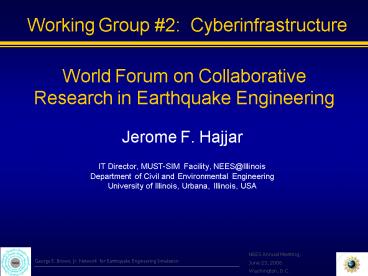World Forum on Collaborative Research in Earthquake Engineering
1 / 11
Title:
World Forum on Collaborative Research in Earthquake Engineering
Description:
George E. Brown, Jr. Network for Earthquake Engineering Simulation. NEES Annual Meeting ... Gregory Deierlein, Stanford University, Stanford, California, USA ... –
Number of Views:85
Avg rating:3.0/5.0
Title: World Forum on Collaborative Research in Earthquake Engineering
1
World Forum on Collaborative Research in
Earthquake Engineering
Working Group 2 Cyberinfrastructure
- Jerome F. Hajjar
- IT Director, MUST-SIM Facility, NEES_at_Illinois
- Department of Civil and Environmental Engineering
- University of Illinois, Urbana, Illinois, USA
NEES Annual Meeting, June 23, 2006 Washington,
D.C.
2
Working Group 2 Objectives
- Explore functionalities for software to improve
international collaborative research and
education programs in earthquake engineering.
Identify the barriers that have hindered
effective collaboration and discuss how
technological solutions can assist in overcoming
these barriers.
3
Working Group 2 Presentations
- Co-Chairs Jerome F. Hajjar, University of
Illinois, Urbana, Illinois, USA - Pierre Pegon, European Laboratory for
Structural Assessment, Ispra, Italy - Satoshi Sekiguchi, Agency of Industrial
Science and Technology, Japan - Recorder Jerome P. Lynch, University of
Michigan, Ann Arbor, Michigan - Joy Pauschke, National Science Foundation, USA
- Cliff Roblee, NEES, Inc., Davis, California, USA
- Shannon Whitmore, NEESit, San Diego, California,
USA - Heon-Young Yeom, Seoul National University,
Seoul, Korea - K.-J. Wang, Natl. Center for Res. on Earthquake
Engrg., Taipai, Taiwan - Martin Williams, University of Oxford, Oxford,
U.K. - Bambang Budiono, Bandung Institute of Technology,
Bandung, Indonesia - Gregory Deierlein, Stanford University, Stanford,
California, USA - Jason Ingham, University of Auckland, Auckland,
New Zealand - Zifa Wang, Institute for Engineering Mechanics,
China - Kazuhiko Kawashima, Tokyo Institute of
Technology, Tokyo, Japan - Reggie DesRoches, Georgia Institute of
Technology, Atlanta, Georgia, USA - Andrea Prota, University of Naples Frederico II,
Naples, Italy - Stephen Mahin, University of California,
Berkeley, California, USA - James Myers, University of Illinois, Urbana,
Illinois, USA
4
WG 2 Framework Current Status
- Collaboration and Cyberinfrastructure
- Current Status Worldwide
- Collaboration is Essential
- Enables ease of idea, process, and data exchange
(within and between disciplines), preservation of
data, and development of new modes of creation to
enable new discoveries - Breadth of collaboration
- Narrow (or passive) exchange of data
- Broad (or active) harness capabilities at
international sites eliminating parochial
group-think opportunities for students in a
global world - Depth of collaboration
- Micro collaboration small group projects to
solve micro-level international earthquake
engineering (EE) problems new systems, new
education - Macro collaboration grand challenge to solve
macro-level international EE problems ?
collaboration permits large-scale - Enables not reinventing capabilities,
country-by-country
5
WG 2 Framework Current Status
- Collaboration is Easy
- Most researchers and many countries are
interested in and are actively participating in
collaborative earthquake engineering research - Earthquake engineering field is positioned well
for collaboration - Few national secrets
- Important (in varying degrees) worldwide
- Many countries are actively building out their EE
infrastructure (testing, analysis, cyber) - Excellent educational/outreach opportunities
6
WG 2 Framework Current Status
- Collaboration is Hard
- Technological cost, management, time
- Cost software development and maintenance
(diverse and complex user needs, open source,
multi-lingual, etc.) hardware to start-up
internationally networking capabilities
worldwide - In a heterogeneous environment, is the lowest
common denominator too low? - Management not possible to manage status quo in
software development - Develop and maintain IT and EE partnerships
internationally - Time information overload spanning time zones
- Sociological
- University culture promotion/tenure/turf
battles - Human culture we collaborate more with those
like us - Priorities and Policies
- Individual vs. multi-institutional vs. global
discoveries - Are we stifling individual creativity as we go
more collaborative? - Synchronization of worldwide funding
7
WG 2 Framework Current Status
- Current Strategies
- In U.S. OCI established cyberinfrastructure
development underway - International data repository (NEESit, etc.)
- Several countries and EU considering developing
standards and protocols
8
WG 2 Framework ACTION
- RESOLUTIONS
- The international earthquake engineering
community embraces collaboration through
cyberinfrastructure as fundamental to the future
success of earthquake engineering discoveries and
education. Broad funding is recommended for
achieving international earthquake engineering
needs within cyberinfrastructure. - New international collaborative research and
education programs should be established within
earthquake engineering to harness current
worldwide investment in cyberinfrastructure,
experimental and computational simulation, and
collaboration tools within earthquake
engineering, inclusive of countries at all levels
of advancement in these fields. - International earthquake engineering
collaboratories should form an alliance to
facilitate establishing worldwide objectives and
strategies, and disseminating worldwide
achievements via cyberinfrastructure and
collaboration.
9
WG 2 Framework ACTION
- RESOLUTIONS (cont.)
- Current cyberinfrastructure activities within
earthquake engineering offer a testbed for
highlighting successes and challenges of adapting
cyber-tools within research and education. The
international community should document and learn
from the successes and challenges in usage of
collaborative cyberinfrastructure activities
within NEES-like environments worldwide. SHORT
TERM - As a first step in international
cyber-collaboration, a catalog of laboratory
expertise, capabilities, and streaming status
should be established to set the stage worldwide
for international collaboration in earthquake
engineering. SHORT TERM - The earthquake engineering community and funding
agencies are encouraged to support one or more
pilot projects that leverage current activities
to accelerate the development and deployment of
transformative tools, procedures, and best
practices for harnessing cyberinfrastructure for
collaboration within the earthquake engineering
community. SHORT TERM
10
WG 2 Framework ACTION
- One or more Pilot Projects to allow the EE/IT
teams to work towards international
collaboration - Strawman Document
- Describe a hypothetical international research
collaboration from start to finish - Enumerate a list of required cyberenvironment
collaboration tools to facilitate international
collaboration for both large facilities and small
groups - Initiate discussion of establishing best
practices for EE testing, simulation, and data
exchange - Establish future meetings of EE and IT community
to drill down on IT needs, procedures, protocols
11
THANK YOU
Urbana-Champaign, Illinois
Chicago, Illinois































